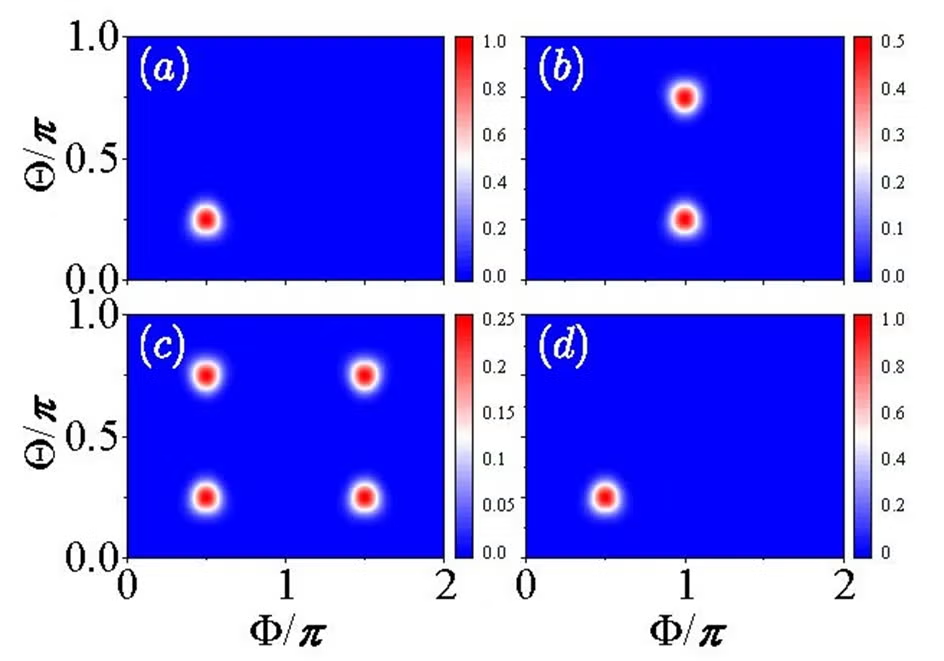According to a study published in Physical Review Letters, researchers at the National University of Singapore (NUS) have made remarkable advances in quantum metrology. This subject uses quantum phenomena to make measurements with extraordinary accuracy. Their newly created protocol has the potential to help develop technologies such as navigation and the detection of extremely weak signals.

Quantum wavepacket dynamics depicting the collective motion of an ensemble of identical spins subject to periodic modulation in their interaction strength. Panels (b) and (c) indicate the generation of highly entangled states during the time evolution. Panel (d) and panel (a) are identical due to quantum recurrence. Image Credit: Physical Review Let
Quantum metrology uses the unique features of quantum systems to produce sensitivities that exceed classical limits. Pushing beyond the so-called standard quantum limit (SQL) to reach the ultimate Heisenberg limit (HL) usually requires highly entangled quantum states, such as Greenberger-Horne-Zeilinger (GHZ).
However, these states are extremely difficult to generate, maintain, and quantify because they are highly vulnerable to environmental noise and readout errors, which are significant barriers to practical implementation.
The study team, led by Professor Jiangbin GONG of NUS's Department of Physics, has created a revolutionary technique that overcomes these impediments. Their technique makes use of quantum resonance dynamics in a regularly driven spin system, which is a well-studied model known as the quantum kicked top. Rather than beginning with a fragile, highly entangled state, their procedure begins with a strong and simple SU(2) spin coherent state.
This simple initial state naturally develops into strongly entangled states that encode quantum information through carefully crafted periodic interactions. Quantum recurrence causes the system to return to its initial coherent state under specific resonance circumstances, allowing for both a simple setup and a reliable readout.
This round-trip evolution means we can start and end with a stable, experimentally friendly state, while still harnessing the quantum-enhanced sensitivity typically associated with more challenging entangled states.
Jiangbin Gong, Professor, Department of Physics, National University of Singapore
The group demonstrated that the measurement precision of their methodology is Heisenberg-limited. Both the number of particles (spins) and the sensing time cause the quantum Fisher information (QFI), a key variable that establishes the highest possible accuracy, to increase quadratically.
In contrast to previous methods, this optimum scaling is resilient to Markovian noise, a prevalent type of environmental decoherence in quantum systems, and can be maintained over long periods of time. The protocol preserves near-Heisenberg scaling with the number of spins even in the presence of such noise, which is a major breakthrough in useful quantum metrology.
This method’s experimental viability is one of its main benefits. By adjusting operational parameters, the protocol may be implemented using current quantum hardware, such as platforms based on trapped ions or cold atoms, and no specialized equipment or intricate state preparation is needed.
Gong added, “This work demonstrates that ultra-precise quantum measurements are achievable without the usual difficulties. By avoiding complicated state preparation and improving resilience to noise, our approach opens new possibilities for practical and scalable quantum sensing.”
This research marks a significant advance in quantum metrology, introducing a noise-resilient and experimentally practical method for achieving Heisenberg-limited measurement accuracy. By leveraging quantum resonance dynamics with straightforward initial states, the approach overcomes persistent hurdles in state preparation and readout. The result is a more accessible pathway to high-precision measurements, with strong potential for integration into next-generation quantum sensing technologies.
Journal Reference:
Zou, Z., et al. (2025) Enhancing Quantum Metrology by Quantum Resonance Dynamics. Physical Review Letters. doi.org/10.1103/lkrt-lvng.